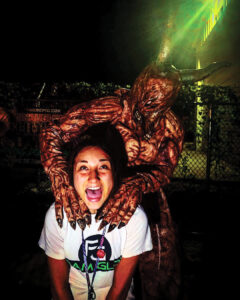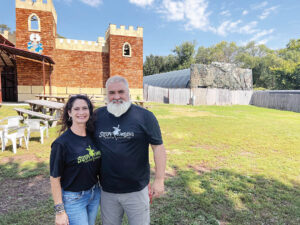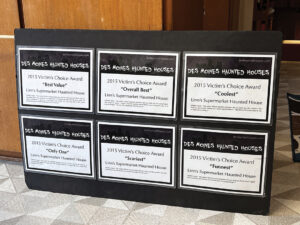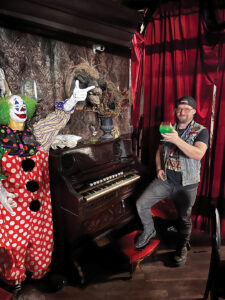The business of fear
10/4/2023
One never knows what might be lurking in the dark at The Slaughterhouse. Photo courtesy of The Slaughterhouse
Falling leaves and pumpkin spice lattes mark the return of seasonal business ventures like apple orchards and pumpkin patches. These businesses promise joy, laughter and happy memories. Haunted houses promise the opposite with fear, horror and terror. The bigger the scare, the bigger the profit, so it may seem. But it begs the question, why would anyone pay to be scared?
“They want the thrill, but they know they’re going to be safe,” said Amy Coble, Sleepy Hollow’s festival director. “So, they can let those inhibitions go and enjoy it.”
The popularity is evident. One night during last year’s season, Sleepy Hollow’s Haunted Scream Park, 4051 Dean Ave., Des Moines, sold as many tickets as they could. Ian Miller, owner of The Slaughterhouse, 500 Locust St., Des Moines, estimated 10,000 patrons return to his haunted house each year. And Linn’s Haunted House, 3805 Sixth Ave., Des Moines, sees lines of hundreds of customers eagerly waiting for admission every weekend.
“The popularity, I think, stems from the fact that being scared is exhilarating,” said Kevin Coble, general manager of Sleepy Hollow’s Haunted Scream Park. “Not knowing where something is coming from is tempting. It’s just your psyche. It loves what it doesn’t know, and, in every haunted house, they know people are in there, but they don’t know where, and they don’t know if it’s a ghost or a werewolf or a vampire or a zombie.”
Running the business

Amy and Kevin Coble have been the head of Sleepy Hollow’s Haunted Scream Park for six years and say it is a mad rush to set up the attraction after the Renaissance Fair. Photo by Colson Thayer
From a business perspective, the more haunted houses in an area, the better, says Coble. In fact, he wants Des Moines to become a “mecca” for the haunt community.
“When you have competition coming in, your immediate reaction is, ‘Oh, what’s that going to do to our numbers?’ ” Coble asked. “We haven’t gone down. We’ve actually been going up. I think when new players come into the game, it entices more people to want to go to multiple.”
Amy and Kevin Coble have been the head of Sleepy Hollow’s Haunted Scream Park for six years. This stemmed from their involvement in the park’s Renaissance Fair. After selling Sleepy Hollow’s land to Polk County Conservation, Rick and Mary Flatt continue to operate the special events that occur at the park. Each year, the Flatts give the Cobles more to work with and more responsibility running the Renaissance Faire and the Haunted Scream Park. Nowadays, the Cobles handle about 90% of staffing and the creative side of the events.
After the conclusion of the Renaissance Faire, the team at Sleepy Hollow have 11 days to convert the Renaissance Village into the Haunted Scream Park. Those are typically 12- to 14-hour days for the crew.
It takes close to 100 people to operate the scream park. That number includes actors, security and medics each night. But they love to do it, said Coble, and the park sees 70-80% retention among employees. Not to mention, recruitment is a breeze, too.
“Quite honestly, we get most of our actors from other actors,” Coble said. “Someone who does it a year or two will bring their brother, their best friend, their siblings, their spouses. We’ve got quite a few husbands and wives, brothers and sisters, fathers, sons, just all over the place.”

Linn’s Supermarket Haunted House displays its Des Moines Haunted House Victim’s Choice Awards for 2015. “Victims” lauded the establishment as the best, not to mention coolest, funniest and scariest.
Merlyn Linn at Linn’s Haunted House is no stranger to hiring family. His wife, brother and kids all come to help him run the attraction in October.
“They’ve been doing this for forever. I keep thinking they’ll say, ‘Dad, I just don’t want to do it anymore.’ But they have fun… They love it,” said Linn.
Since 1984, Linn has owned and operated his haunted house out of the basement of the supermarket he used to own. After selling the store, his contract with the new owner will allow him to continue operating the haunted house for a few years.
“The day will come, which I really dread. That’d be the end of it,” said Linn. But for now, the Des Moines staple continues to operate.
Linn spent two years creating the haunted house in the basement of Linn’s Supermarket before it saw its first patron. Back then, he charged $1.50 per entry. He remembered filling five-gallon buckets with change.
Over the years, Linn had to keep up with constantly changing regulations and rising expenses. He’s had to install fire alarm systems, create new emergency exits, buy a backup generator and more just to keep his attraction open.
“I think one year I went in the hole because of everything I had to do. But I did it. They weren’t going to let me open,” he said.
Insurance was also something that led to an increase in the price of admission.
“I have to cover the City of Des Moines, myself, and the store. So, I spent thousands for insurance alone,” he said.
At the end of the day, purchasing insurance, providing ample warnings for patrons and properly training employees can make or break a haunted house.

For those who find clowns scary instead of funny, The Slaughterhouse features one in its scenes.
Photo by Colson Thayer.
“The more you have to communicate to the attendees that we have constant surveillance, constant security, an off-duty officer on hand, the less problems you see,” said Ian Miller, owner of The Slaughterhouse.
“We have definitely had problematic customers. We’ve had problematic employees just like any other company. We face the same types of challenges,” Miller said. “I would say that the one thing that we face more than anything is like a heightened emotional response in any situation XYZ because we are theatrical.”
In fact, Miller sees the entire operation as a more demanding type of theater.
“First of all, you’re not dealing with a stage and a seated audience. People are walking through these environments that all have to be safe. They all have to be checked. They all have to be maintained and cleaned regularly,” said Miller. “We’re also dealing with animatronics that have pneumatic power. You’ve got pneumatics, you’ve got electronics, you’ve got all of these aspects that in a standard theater setting is all contained at the stage. But, in our environment, the whole place is the stage. So, if you think about the safeties that are necessary and the maintenance necessary where the audience is (moving around), it kind of illustrates how dynamic this kind of operation is.”
The Slaughterhouse has a team of about a dozen who work year-round to handle the size of their operation. The team includes full-time department directors in charge of scenery, costumes and makeup; staff management; hiring and sales. When fall comes around, the size of their team is close to 100, accounting for actors, operators and security.
As far as marketing, Miller uses traditional forms such as billboards and posters. He also works with his collaborative partners at Lucky Gal, Jay’s CD & Hobby and Zombie Burger. These businesses act as poster outlets and provide social media promotion. He also uses email marketing to get people to return.
The season of scare
“We do have an amazing fan base,” said Miller. “Many repeat attendees not only return season to season but some multiple times in a season. We have a good fan base of about 10,000 patrons that just return year after year. And then there’s, of course, a percentage over the top of that that are new.”
Loyal fans are common for haunted houses.
“One person said, ‘I’ve been here every year,’ ”
said Linn, whose haunted house has been in operation for almost four decades. “They bring new people, and then those people bring new people.”
For many haunted house attendees, it is an annual tradition that keeps people coming back.
“This is a tradition in central Iowa. We have been going for 30 years. So we do keep those that come back,” said Amy Coble. “We email them, keep in contact with them so that they’re aware of the dates. We’ve run into people who came as kids, bringing their kids now.”
For Sleepy Hollow, their operations and business extend well beyond the month of October with various events and winter sports throughout the year. Linn was able to keep his haunted house alive with the support of his grocery store upstairs. The Slaughterhouse, on the other hand, is all in on the haunts.
In addition to their own haunted house, The Slaughterhouse is contracted by Adventureland and Palace Entertainment to hold the Phantom Fall Fest. The Slaughterhouse helps manage theatrical operations and builds multiple environments for the park.
“The business of Halloween is definitely a challenging one,” Miller explained. “We have found that, in order to sustain our seasonal staff… as well as growing our operation, it’s become essential to branch out into events outside the Halloween season.”
The Slaughterhouse has explored and experimented with events year-round including Krampus in December, St. Patty’s Day and Valentine’s Day.
But what Miller is most excited and nervous about is the opening of their year-round theater bar venue, The Haunt. The venue will open at the end of The Slaughterhouse’s 2023 season inside of their already existing haunted house.
“October actually is almost the relief valve, because we work so much throughout the year. Then when we get to October, it’s really just showtime,” said Miller. “Honestly, this year is going to be balls to the wall all the way through the season and postseason because we’re opening this new venue. So, this is the first time in many years that we won’t be able to take a big sigh of relief.”
Labor-intensive fun
For now, area haunted houses rely on good, old-fashioned scares provided by enthusiastic “scarers” — people who enjoy participating in the theatrics. As with many industries, the potential is there to modernize. As amusement technology continues to advance, the haunted house industry has the opportunity to make big changes. Animatronics and special effects could revolutionize the haunted house experience — but maybe not so soon.
Coble doubts that technology can match the human performance of a good scare.
“If I’m going to a haunt, and 20 animatronics jump out at me and then just roll back into place, and one actor jumps at me… I’m going to go, ‘There’s only one person there,’ ” he said. “If it’s reversed and there’s 20 people and one animatronic, I’ve already forgotten the animatronic.” ♦


















